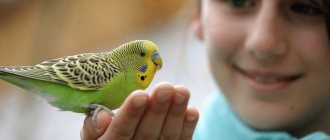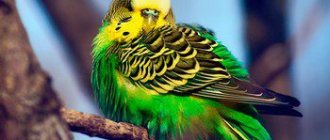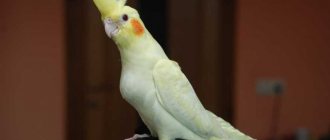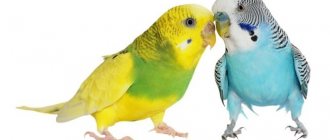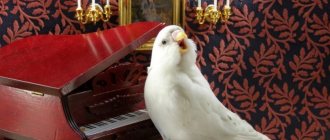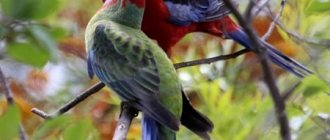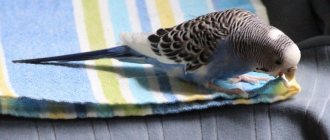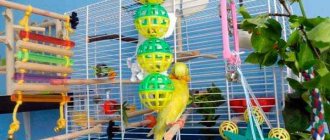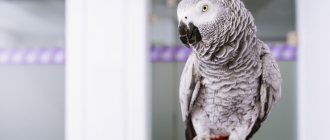Many people try to teach budgies to speak, but such aspirations do not always have results. However, practice shows that these sociable birds become capable students if you communicate with them correctly.
Let's find out how to teach a budgie to talk, and whether all representatives of the breed are able to speak after special training.
Recommended age to start training
Budgerigars become adults by 9–10 months. It has been noticed that young birds cope much more successfully with sound imitation lessons than adults.
Experts believe that the optimal time when a parrot begins to accept training is from 1 to 4 months. While the teenage bird is in the nest, they do not work with it. If a person begins to regularly communicate with a budgie that has been separated from its parents, it will start talking within 3–3.5 months.
Interesting! Even the most experienced trainer cannot quickly teach five-month-old (and older) wavy dogs to talk. This will require several months and a lot of patience from the owner. There will be a result, but only if the parrots have a balanced diet and good care for them.
Are all parrots able to speak?
Many representatives of the parrot family speak (Greys, Amazons, Macaws, Cockatoos, Lorises, Corellas, Quakers, Eclectuses). The pronunciation of words is facilitated by the structure of the vocal apparatus and the natural desire to imitate sounds (parrots also do this in the wild - they repeat the singing of other birds and the cries of animals). But there are birds that it is useless to teach to speak - they have a small, flat tongue, suitable for trills, but not for clearly pronouncing words. In addition, such birds lack the desire to imitate. Such non-speaking parrots are rosellas and all representatives of the genus Psephotus.
You can make budgies talk. But they are more difficult to train than macaws or cockatoos. The reason is that wavy animals take longer to get used to humans (therefore, at first they do not try to imitate their owner). It is also important that, in comparison with its larger counterparts, the motley bird has less developed areas of the forebrain responsible for learning: it requires more time to analyze the information received and memorize.
Video: example of a chatty budgie
Does the ability to speak depend on gender?
All breeders agree that it is much more difficult to teach wavy girls to talk than males.
The owner, who has spent a lot of effort teaching the female to speak, is rewarded with clear pronunciation of words and entire phrases. This is considered a big victory. There are cases when a female taught the correct pronunciation of the words of a male placed next to her.
Conversely, a well-trained boy usually begins to share his skills with a young girlfriend assigned to him.
Interesting! It is much easier to teach a bird to talk if the parrot is alone in a cage. A pair of wavy cats that live together are always busy with each other and it is useless to teach them sound imitation at home.
Teaching Methodology
Before you begin training with a bird, you should make sure that the parrot is ready for it. It is not recommended to train a newly acquired pet. The bird is given time to adapt, and only after that can you communicate with the budgie and begin training it.
It has been noticed that parrots perceive people with a high-pitched voice better. If the winged pet's teacher is a woman or child, the bird's chances of successfully training will increase significantly. The same person should always handle the parrot - the one whom the pet will get used to considering as its owner.
Table 1. Stages of training a budgerigar
| Stages | Actions |
| Selecting the first (one) word | Most often this is the name of a bird. If it's long, it's better to choose another word. The sound combination should be light and short and contain sibilant consonants. |
| First lesson. Repeating one word | Make eye contact with the parrot. Then slowly and calmly repeat the word several times, observing pauses. If a bird tilts its head and opens its beak, it means it is interested. This is an excellent sign of successful training for this particular parrot. |
| Consolidation. Daily classes for 10–15 minutes | Clear articulation during pronunciation at a slow tempo. Maintaining a sequence of repetitions over several sessions. |
| Increasing pauses between word repetitions | Give the bird the opportunity to repeat the word. The parrot's first responses contain many hissing sounds, creaks and whistles. Later, sound combinations appear that resemble the word. |
| Praise | Give your pet a treat and express your approval with words; if possible, let him fly outside the cage. |
Important! If your pet is upset about something, it is better to postpone the lesson.
It is important to conduct lessons in a quiet environment, with the TV and cell phone turned off. Experts advise removing toys from the bird’s home during the lesson to eliminate moments of distraction. After the lesson, all game attributes return to their places.
“Hello, prosecutor’s office!”: in Kaliningrad, a talking female parrot became a YouTube star (video)
- In contact with
- Telegram
- Link
A talking female parrot named Petrunya writes poetry, quotes detective stories and collects hundreds of thousands of views on YouTube. The owner of the bird, Kaliningrad resident Alexander Mayer, allowed Klops correspondents to ask the feathered star questions that concern our readers.
An African red-tailed gray appeared in the family of Alexander and Yulia in 2021. We ordered a parrot from a breeder from the Czech Republic for 45 thousand rubles. At first they thought that Petrunya was a male, but later the ornithologist came to a different conclusion. They did not change the name.
Such birds live in Angola, where they are called forest rats: according to a Kaliningrad resident, because of their enormous appetite. Not all Gray Gray chicks can talk; the Mayers were lucky. But in order for the parrot to start communicating, you need to work with it.
Jaco needs to be taught action words, for example: “Petrunya wants to drink, sleep, eat,” and so on. Yesterday I said to her: “Petrunya wants to sleep?” She answered: “Yes,” flew into the kitchen, where she always sleeps, and fell asleep. She clearly knows what needs to be done,” said Alexander Mayer.
Petrunya also remembers those words or phrases that made an impression on her. For example, one day she was left alone in the apartment with the TV on, after which she began to quote a detective story.
You teach her to sing a song about Antoshka, and she says: “I will kill you. Do not kill me. And I say: hello, prosecutor's office! Would you like some coffee? Will you have some coffee?”, and so emotionally, and we didn’t teach her that.”
At that time, Petruna was six months old. By her third anniversary, Gray knew 400 words.
She tries to sing Talkov’s song “Summer Rain” and whistles the tune exactly. So far, large phrases are difficult for her. In general, parrots begin to talk after three years, she will talk more. She also swears constantly, calls you a “dog” if you criticize her, says: “Oh, what are you, oh, oh!” He will say: “Petrunya wants to eat,” and if you don’t give food, he says: “Sasha is miserly, Petrunya wants to eat.”
The recording of Petrunya having lunch became the most popular on the YouTube channel run by Alexander. It received 960 thousand views.
The video of Petrunya allegedly eating a sausage was staged. It received almost a million views, and then the number of subscribers reached 50 thousand and continues to grow.”
Petrunya can also boast of literary skills. She writes poetry. “She flew up to me, sat down and said: “Just a second.” And she began to tell: “Moshka, kokoshka, like kittens have a frog.” How could she say it in rhyme? And she knows that this is her verse,” says Alexander.
The parrot's talents did not go unnoticed. Petrunya and her owner became the heroes of the “Animal Reporter” program on the “Living Planet” TV channel.
We won something there, but I didn’t even watch the broadcast. We were also invited to the “Saw Video” program on Channel One, but then the coronavirus happened. If they call us again, I think we won’t refuse.”
Fast way to learn
Teaching birds to sound imitate human speech is a slow and painstaking process. At least 2.5–3 months will pass before the owner of the wavy notices that the pet is talking.
To speed up the results, you should pay attention to the following points:
- During the lesson, the bird should be slightly hungry. This stimulates her activity.
- You should not delay classes so as not to discourage the parrot from wanting to communicate.
- You need to start learning with short words.
- Constantly monitor your pronunciation.
- Do not show aggression towards your pet, even if something doesn’t work out for him.
It has been noticed that budgies learn to speak faster if the owner uses the technique of twice-daily training. Such classes are conducted with a significant period of time between them and last no more than 10–12 minutes. For example, you could have your first lesson at around 9am and your second at around 5pm.
When to expect the first words from your parrot
To train a little bird you will have to be patient; the first results should be expected no earlier than after 2-3 months of daily training. Sometimes the process can drag on even more if the parrot is stubborn (there are cases when the bird begins to speak only a year after the first lesson).
It is useless to train a very small chick or an old bird; the optimal age for training is considered to be from 2 months to 2 years
Alas, budgerigars that can be taught to speak in a couple of weeks or days are very rare, so you still shouldn’t count on such a quick result.
Is it possible to teach an adult budgie to talk?
Ornithological experts believe that the older the bird, the more difficult it is to work with it in terms of training. It is possible to talk to an elderly male. But older females are no longer amenable to training.
To get a rough idea of the age parameters of a bird, you need to pay attention to its plumage. In young parrots that have not yet undergone their first moult (about 3 months), the feathers on the head have a wavy color until the beak begins.
Signs of young wavy birds are also:
- short tail;
- smooth skin on paws;
- black eyes;
- pale shade of feathers.
Interesting! It happens that adult birds are more talented than young ones. It all depends on the individual characteristics of the parrot.
How to choose a capable one
When purchasing an adult bird, it is better to give preference to potentially talkative individuals. They can be recognized by their specific behavior:
- The parrot behaves calmly and has a good appetite.
- The bird always pays attention to the world around the cage, listens, looks closely and is not afraid of people.
If you work with such a parrot in a calm environment, you will definitely get results. The method of training adult pets is common for birds of any age.
Tips and tricks
When parrots say words or combinations of words, this does not mean that they understand the meaning of what was said. Birds simply imitate a sequence of sounds.
Experts advise that after the first 10–12 lessons you associate the pronunciation of a task word with a specific situation. It is better to choose actions that are repeated day after day. For example, a greeting at a meeting, an invitation to a meal or a swim (“eat”, “swim”, “hello, Kesha”).
Experienced breeders confirm that the main success factors are:
- patience;
- competent approach;
- motivation;
- lack of stress;
- regularity of training.
To consolidate the achieved results, a mirror removed from the cage during training helps a lot. The parrot, who is satisfied with the communication with the owner, immediately begins to “tell” the attribute placed in its usual place about its successes and repeat the memorized sounds.
Birds mistake their reflection for a cute relative, and are happy to share the news with him.
